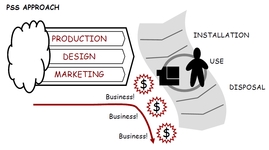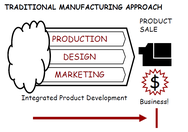Product/Service-System (PSS) design
[innovation strategies where companies provide value to their customers through service provision rather than product sales]
There is nothing new in the fact that companies offer products and services together. Every product involves services such as sales, delivery, maintenance and repair services (Grönroos 2000), and every service involves physical products in order to provide the benefit (Shostack 1982; Bitner 1990). Yet, traditionally in most companies the development of services and products has been separated - both in terms of process and of organisation. This has entailed that the potential for products and services to mutually support each other has

not been properly articulated.

The concept of Product/Service-Systems (PSS) can be traced back to prior environmental concerns of how the world’s economy is currently coupled with material and energy consumption. The possibility that economic growth could still be achieved without compromising the Earth’s natural environment, was widely recognised under the term sustainable development in the 1987 Brundtland report (Brundtland 1987).
One of the strategies to decouple material and energy consumption with economic growth is to substitute a material product with an immaterial way of fulfilling the same need or function, i.e. a service (Mulder 2006). This approach is called ‘dematerialisation’, where the aim is to fulfil a need by consuming significantly less material and energy. Stahel and Reday (1976/1981) were among the first to consider the potential to develop a more labour-intensive and less energy-intensive economy through product-life extension. Compared with manufacturing, this constitutes a substitution of manpower for energy, and decentralised workshops instead of centralised factories. Stahel (1997) uses both the terms ‘service economy’ and ‘functional economy’ synonymously to describe this approach to sustainability.
References
- Bitner, M.J. (1990). Evaluating service encounters: the effects of physical surroundings and employee responses, Journal of Marketing 54(2): 69.
- Brundtland, G.H. (1987). Our Common Future: The World Commission on Environment and Development, Oxford, Oxford University Press.
- Grönroos, C. (2000). Service Management and Marketing: A Customer Relationship Management Approach, John Wiley & Sons.
- Mulder, K., Ed. (2006). Sustainable Development for Engineers, Greenleaf Publishing.
- Shostack, G.L. (1982). How to Design a Service, European Journal of Marketing 16(1): 49-63.
- Stahel, W. and Reday, G. (1976/1981). Jobs for Tomorrow, the Potential for Substituting Manpower for Energy. New York, Vantage Press.